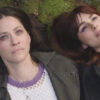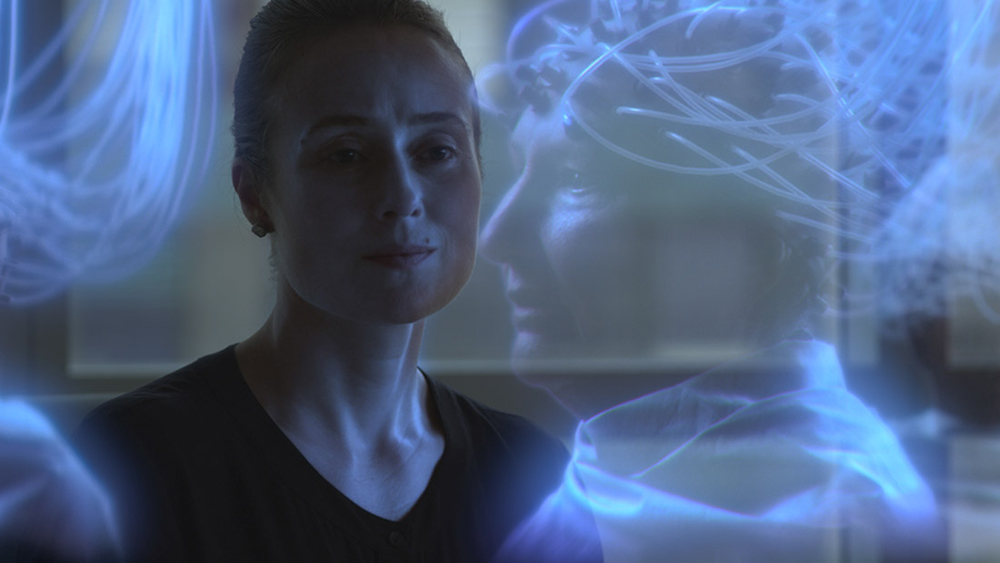When you create a film teeming with ideas about the future of our world, social strata, patriarchy and singularity, it’s hard to know where to start if you ever have to explain it, as “Advantageous” director Jennifer Phang has found.
“On Netflix, it’s categorized as a ‘cerebral’ film,” Phang says with a laugh, “So I guess that says enough.”
Perhaps that is all one might want to know about “Advantageous” before seeing it, given all the surprises Phang has in store, but it’s also worth mentioning that audiences shouldn’t be intimidated by it. Boiled down to its essence, the expansion of the short of the same name that Phang made for ITVS’ “Futurestates” series a few years back, is the story of a mother named Gwen (Jacqueline Kim) who just wants the best for her daughter Jules (Samantha Kim). Having recently been laid off by the Center for Advanced Health and Living, a company on the verge of a breakthrough in terms of transferring consciousness from one body to another, Gwen struggles with putting Jules into a private school that could set her up for life, ultimately wondering if she should take part in her former employer’s latest experiment to help her cause.
As dire a decision as Gwen faces, Phang never falls into the dystopian tropes of her predecessors, cannily building a world not far from our own that’s awesome in all the ways its characters have advanced technology. Then again, perhaps that’s what makes the future Phang envisions so much scarier than those that use technology as a villain, since the true obstacles facing Gwen and Jules are societal attitudes that have been ingrained since the start of time and can’t be fixed simply with a flip of a switch.
Fittingly, “Advantageous” is making its debut on Netflix today in order to reach an audience worthy of its ambition at the same time it is opening theatrically in New York and San Francisco, where its cinematic envelope pushing, particularly by composer Timo Chen and cinematographer Richard Wong, may best be appreciated. Shortly before the film’s global takeover, Phang spoke about how she was inspired to expand on her 2012 short, building meaning into the physical and sonic architecture of the film, and the influence of old fashioned chamber dramas in creating tension for this newfangled future.

A lot of things, but there was the love of the themes, the process, and the story from the crew that was very clear. They were basically our first audience that I was testing the idea on. Also, the passion from Samantha’s mother, Nina, who really believed in the project. The story has some very important issues for parents and mothers [specifically], and it’s never been done this way before, so she gave me a lot of confidence. In between takes, I’d ask her, “Do you think I should turn this into a feature?” And she said, “Definitely.” Jacqueline was very excited to do it and I asked her to write the feature with me because I could tell there was a real writer and artist inside of her. I think she’s been a participant in the creative process of making many films, but I believe it was the first time she had officially come on as a co-writer officially and we went to a retreat together, working things out like the structure. Between the two of us there were a lot of ideas and really the only challenge was to figure out where the focus would be, but I’m happy with how it turned out.
One of the interesting ideas this film gets at, at least for me, was the notion that cultural identity is something that no longer may be made up of a collection of inherent traits but can be manufactured. Was that actually a starting place for you?
What you’re saying makes me think of a lot of things. In the course of releasing [this film], a lot of people bring up things like identity and singularity and I think because access to information and ideas has increased exponentially in the last ten to fifteen years, we are becoming more of a society that is so fragmented in terms of having different perspectives. It’s easier for people to collect ideas that make sense to them, so everybody’s identity right now is a fusion of inherent and cultural value systems and also global value systems, so in a way, there’s a higher self awareness and self consciousness, but it’s also a little bit of a dilution of personal journeys. People don’t have as many personal journeys because those personal journeys have been manufactured for us by media. Some people make an active choice to remove themselves from too much media, but it’s hard because if you do, then you’re falling behind the rest of the world, so in order to keep pace with the world, we have to sacrifice our individuality. That’s what I’m feeling is part of the problem.
In the case of Gwen and Jules [in the film], Gwen knows this in a way, so she tries to keep Jules in an analog world. That means spending time with music and things that don’t involve computers — singing, dancing, being in the park. This is something that Jacqueline and I developed because that’s something that both of us relate to — we need to find our own time and space to be separate from the internet and media. We both value more one-on-one, face-to-face [time] with people and fortunately, filmmaking allows for that because there’s so many partners involved.
You allude to the scenes where Gwen and Jules are able to play music with one another. How did you chose what music they would play? Specifically, that opening hymn is a really interesting choice.
Yeah, that was a beautiful thing and a testament to embracing collaboration. When I first spoke with Jacqueline about doing the short film, I wanted to make sure we were playing to everyone’s strengths. As luck would have it, Jacqueline has a million strengths and one of them is playing piano. I started to realize what her proclivities were and it was really fortuitous. She was sending me ideas for music and I narrowed it down to the solo piece that she plays in her reflective moment and also that hymn that you’re talking about which is called “Il Est Ne Le Divin Enfant” (He Is Born, the Divine Child), which is an old Christmas carol that is often played in France during Christmas.
You’ll notice that most of the songs with words in our film are about Jesus Christ and for me, it was working well because it reminded me how focused some parts of our world are on the patriarchy and following the leadership or moral compass of men. That’s something that’s been part of everyone’s life, not necessarily good or bad, but because our society is saturated with a fixation on male leadership, I thought it was a fun irony to have this girl and this woman whose lives are being pushed around a little bit by this patriarchy.
Did it actually impact the way you wrote this at all that Samantha Kim, who plays Jules, was slightly older?
Yes, we decided we could embrace a slightly more sophisticated version of Jules, which just meant that she would be able to be more verbal and engage with what was going on in the world, less of a victim and more of a participant. At the same time, we also wanted her to be more analytical but respective and even call her mother out on some of her own concerns. She’s a little more confrontational character.
You’ve described “Advantageous” in other interviews as being inspired by chamber dramas, which is an interesting comparison given how isolating the future seems to be in terms of communication where characters will appear as if they’re speaking to themselves when in fact their consciousness allows them to communicate with others from afar – obviously, not a stretch when we see people now on their Bluetooth headsets. Was that a case of something old becoming new again in terms of creating tension?
Definitely. As I grew into my taste for cinema, I became more and more fascinated by how people use words for power and pushing people around. They are just words, but they mean so much, especially in films like “The Age of Innocence,” where it’s only words, but it tears people apart — words and money, but mostly the words. It’s actually very true to life now in the world that I exist in, [seeing] the lives of families and single and young people. Part of [the inspiration] was witnessing how power dynamics worked in every situation and this really stark contrast in opportunity for people from different economic classes living in New York. I was able to see it every day on the subway. A lot of people will say that it should be about showing and not telling, but I’ve had some very visceral responses to conversations in films and Jane Austen and Edith Wharton have shown that fixation on human interaction can be a successful one.

Our efforts in sound were extensive because we knew we’d rely on it heavily to create a unique world that was near into the future, but took into consideration accents and changes in technology. You can never have enough time for sound in my experience. From a musical perspective, even before we started pre-production development, Timo Chen, the composer, and I were developing ideas. I asked him to find things that felt both organic and technological and interweave these ideas somehow in the instruments he chose. So he used [everything from] a toothbrush and a vibrator as well as this amazing professional violinist [all with the idea of] bringing old sounds and adding electronic textures. The idea of bringing old and new together was very important to us. Then with the sound design, everything from all the major technological moments we had to get just right. Tyler Straub, our sound designer, and I worked on really finding sounds that were just slightly off of what was familiar to us today, like using Apple products. I wanted it to feel subtle enough so it reminded us the sounds we were used to on our phones, but then just a little more musical and elegant.
As for the visual effects aesthetic, I was working with Jean Elston, who is our visual effects art director and I wanted to bring this sense of a lot of curvature — a movement away from rectangles and more the idea of these ovals that are these rounded edges on monitors. I felt that the designers of the future would want architecture and design that reminded them of nature. We even had these holographic images floating sometimes to remind us of being under water. All my direction usually said “floating.” I also wanted colors that were lively but I didn’t want to use the same color palette that I’ve seen in other science fiction films, so we spent a lot of time finding pastels that worked beautifully when they were glowing.
For the architecture of the cityscapes, we looked at making buildings that reminded us of the shape of people because that was something that was a vision of mine from a long time ago, but again, it made sense that there was a poetic irony. The Cryer building looks a bit like the shape of an “ideal” woman’s torso, because this is a corporation that’s building ideal people — optimized people — to give normal every day people an advantage, right? So their building is in the shape of a body with an advantage, but the layer on top of that is that the woman who runs and mans the company, her name is Isa Cryer, played by Jennifer Ehle, and it’s a pun — I’m saying this woman cries — but the woman that we see is very tough, so there’s a question inside of there whether or not she cries or not for what she does to other people.
Another building was called the Orator because I was thinking about different roles of women and [this building] was [shaped like] a woman who was crouching, but trying to speak and out of her mouth came the steam that dissipates into the air. That steam for me symbolized something like ideas or words — a woman’s voice not being heard even though she’s speaking, and just the idea of women finding a voice, so there were lots of equality ideas in all the architecture.
With so much effort put into communicating all these ideas, what’s it’s been like for you to take all of this on the road? Does a film like this reveals itself after you’ve seen it with an audience and how they react?
Yes, after Sundance we had a little bit of time to polish it between then and our release. We had technical and finishing challenges which happens when you get to Sundance because you don’t know [if you’ll get in], then once you know, suddenly you have more support, but you don’t have enough time. Now, our release is been going quite well for a lot of reasons. [The film is] paced a little bit better. But at Sundance, the response was really exciting because we got some terrific reviews and now the film has opened up a little bit more to a more general audience, people are connecting with it more and more. We’re doing a theatrical release in New York and San Francisco, and the reason I’m choosing those two cities is not only because we have connections to those cities and both of those cities inspired me, but I think the audiences of those cities are excited about work that is trying to do something new and fresh.
I’m finding that audiences really likes to sink their teeth into it. They’re asking all of these very provocative questions and it’s for people who like to analyze and consider the state of our world. That’s asking a lot and I’m saying it with a smile because I know it’s a very lofty ambition, but I’d like for people to look at their participation in the world.
“Advantageous” opens on June 26th in New York at the Cinema Village and in San Francisco at the Roxie Theater. It is also now available on Netflix.




